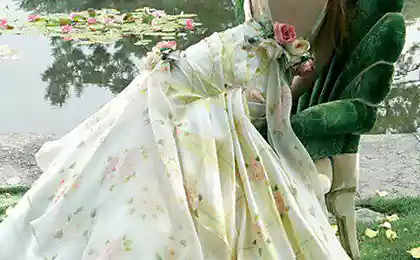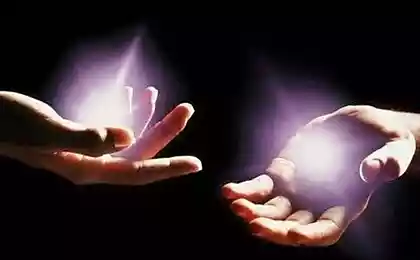738
What is the "wave of death"
Farewell greetings from mozga
There is such a thing as a "living electricity". This electricity, which is produced by living things, such as yourself. By the way, while walking person produces so much electricity that would be enough to charge a smartphone.
Living electricity is the cause of many very strange things, of which probably the most well-known - "wave of death».
Opening the "wave of death" caused a new debate about the existence of the soul and of the nature of "near-death experience", which sometimes tell people who have experienced clinical death. In 2009, the year in an American hospital were taken entsefologrammy nine people dying, which at that time was not saved. The experiment was conducted to resolve a long-standing ethical debate about whether, when a person is really dead.

The results were sensational - after the death of the brain in all subjects, which has had to be put to death, literally exploded - it appeared incredibly intense bursts of electrical impulses that have never seen a living person. They arose in two or three minutes after cardiac arrest and lasted about three minutes.
Before that similar experiments were conducted on rats, in which the same began minute after death and lasted 10 seconds. Such a phenomenon scientists have dubbed the "wave of death." The scientific explanation of the "wave of death" caused many ethical questions.
According to one of the experimenters, doctors Lakhmira Chawla, like bursts of brain activity due to the fact that the lack of oxygen neurons lose their electrical potential and discharged by emitting pulses "like an avalanche." "Live" neurons are constantly under a slight negative voltage - 70 minnivolt, which is held by getting rid of positive ions that remain outside. After the death of the equilibrium is disturbed, and the neurons are rapidly changing the polarity of a "minus" to "plus". Hence, the "wave of death».
If this theory is correct, the "wave of death" on entsefologramme pursuing the elusive line between life and death. After it work the neuron can not be recovered, the body is no longer able to receive electrical impulses. In other words, the more doctors there is no sense to fight for the life of man. But, if you look at the problem from the other side. To suggest that a "wave of death" - the last attempt of the brain to the heart electrical discharge to regain his job. In this case, during the "wave of death" should not put hands, but rather to use this chance to save lives. So says the doctor-resuscitator, Lance Becker of the University of Pennsylvania, pointing out that there were cases when people "come alive" after the "wave", which means a bright burst of electrical impulses in the human body, and then the recession can not yet be considered final threshold.
Author: Alice Muranova
Source: Russian Seven em>
via factroom.ru

There is such a thing as a "living electricity". This electricity, which is produced by living things, such as yourself. By the way, while walking person produces so much electricity that would be enough to charge a smartphone.
Living electricity is the cause of many very strange things, of which probably the most well-known - "wave of death».
Opening the "wave of death" caused a new debate about the existence of the soul and of the nature of "near-death experience", which sometimes tell people who have experienced clinical death. In 2009, the year in an American hospital were taken entsefologrammy nine people dying, which at that time was not saved. The experiment was conducted to resolve a long-standing ethical debate about whether, when a person is really dead.

The results were sensational - after the death of the brain in all subjects, which has had to be put to death, literally exploded - it appeared incredibly intense bursts of electrical impulses that have never seen a living person. They arose in two or three minutes after cardiac arrest and lasted about three minutes.
Before that similar experiments were conducted on rats, in which the same began minute after death and lasted 10 seconds. Such a phenomenon scientists have dubbed the "wave of death." The scientific explanation of the "wave of death" caused many ethical questions.
According to one of the experimenters, doctors Lakhmira Chawla, like bursts of brain activity due to the fact that the lack of oxygen neurons lose their electrical potential and discharged by emitting pulses "like an avalanche." "Live" neurons are constantly under a slight negative voltage - 70 minnivolt, which is held by getting rid of positive ions that remain outside. After the death of the equilibrium is disturbed, and the neurons are rapidly changing the polarity of a "minus" to "plus". Hence, the "wave of death».
If this theory is correct, the "wave of death" on entsefologramme pursuing the elusive line between life and death. After it work the neuron can not be recovered, the body is no longer able to receive electrical impulses. In other words, the more doctors there is no sense to fight for the life of man. But, if you look at the problem from the other side. To suggest that a "wave of death" - the last attempt of the brain to the heart electrical discharge to regain his job. In this case, during the "wave of death" should not put hands, but rather to use this chance to save lives. So says the doctor-resuscitator, Lance Becker of the University of Pennsylvania, pointing out that there were cases when people "come alive" after the "wave", which means a bright burst of electrical impulses in the human body, and then the recession can not yet be considered final threshold.
Author: Alice Muranova
Source: Russian Seven em>
via factroom.ru
How to get around the machinations of marketing, and not spend too much time in the sales
2500-year-old scientific mystery of why we yawn























